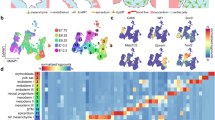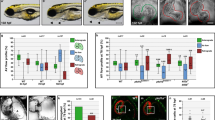Abstract
Truncation of the tumour suppressor adenomatous polyposis coli (Apc) constitutively activates the Wnt/β-catenin signalling pathway1. Apc has a role in development: for example, embryos of mice with truncated Apc do not complete gastrulation2. To understand this role more fully, we examined the effect of truncated Apc on zebrafish development. Here we show that, in contrast to mice, zebrafish do complete gastrulation. However, mutant hearts fail to loop and form excessive endocardial cushions. Conversely, overexpression of Apc or Dickkopf 1 (Dkk1), a secreted Wnt inhibitor3, blocks cushion formation. In wild-type hearts, nuclear β-catenin, the hallmark of activated canonical Wnt signalling4, accumulates only in valve-forming cells, where it can activate a Tcf reporter. In mutant hearts, all cells display nuclear β-catenin and Tcf reporter activity, while valve markers are markedly upregulated. Concomitantly, proliferation and epithelial–mesenchymal transition, normally restricted to endocardial cushions, occur throughout the endocardium. Our findings identify a novel role for Wnt/β-catenin signalling in determining endocardial cell fate.
This is a preview of subscription content, access via your institution
Access options
Subscribe to this journal
Receive 51 print issues and online access
$199.00 per year
only $3.90 per issue
Buy this article
- Purchase on Springer Link
- Instant access to full article PDF
Prices may be subject to local taxes which are calculated during checkout




Similar content being viewed by others
References
Fodde, R., Smits, R. & Clevers, H. APC, signal transduction and genetic instability in colorectal cancer. Nature Rev. Cancer 1, 55–67 (2001)
Fodde, R. et al. A targeted chain-termination mutation in the mouse Apc gene results in multiple intestinal tumors. Proc. Natl Acad. Sci. USA 91, 8969–8973 (1994)
Mao, B. et al. LDL-receptor-related protein 6 is a receptor for Dickkopf proteins. Nature 411, 321–325 (2001)
van de Wetering, M. et al. The beta-catenin/TCF-4 complex imposes a crypt progenitor phenotype on colorectal cancer cells. Cell 111, 241–250 (2002)
Wienholds, E., Schulte-Merker, S., Walderich, B. & Plasterk, R. H. Target-selected inactivation of the zebrafish rag1 gene. Science 297, 99–102 (2002)
Hashimoto, H. et al. Zebrafish Dkk1 functions in forebrain specification and axial mesendoderm formation. Dev. Biol. 217, 138–152 (2000)
Dorsky, R. I., Sheldahl, L. C. & Moon, R. T. A transgenic Lef1/beta-catenin-dependent reporter is expressed in spatially restricted domains throughout zebrafish development. Dev. Biol. 241, 229–237 (2002)
Heisenberg, C. P. et al. A mutation in the Gsk3-binding domain of zebrafish Masterblind/Axin1 leads to a fate transformation of telencephalon and eyes to diencephalon. Genes Dev. 15, 1427–1434 (2001)
van de Water, S. et al. Ectopic Wnt signal determines the eyeless phenotype of zebrafish masterblind mutant. Development 128, 3877–3888 (2001)
Walsh, E. C. & Stainier, D. Y. UDP-glucose dehydrogenase required for cardiac valve formation in zebrafish. Science 293, 1670–1673 (2001)
Kielman, M. F. et al. Apc modulates embryonic stem-cell differentiation by controlling the dosage of beta-catenin signaling. Nature Genet. 32, 594–605 (2002)
Willert, J., Epping, M., Pollack, J. R., Brown, P. O. & Nusse, R. A transcriptional response to Wnt protein in human embryonic carcinoma cells. BMC Dev. Biol. 2, 8 (2002)
Brown, C. B., Boyer, A. S., Runyan, R. B. & Barnett, J. V. Requirement of type III TGF-beta receptor for endocardial cell transformation in the heart. Science 283, 2080–2082 (1999)
Kim, R. Y., Robertson, E. J. & Solloway, M. J. Bmp6 and Bmp7 are required for cushion formation and septation in the developing mouse heart. Dev. Biol. 235, 449–466 (2001)
Iwamoto, R. Heparin-binding EGF-like growth factor and ErbB signaling is essential for heart function. Proc. Natl Acad. Sci. USA (2003)
Mjaatvedt, C. H., Yamamura, H., Capehart, A. A., Turner, D. & Markwald, R. R. The Cspg2 gene, disrupted in the hdf mutant, is required for right cardiac chamber and endocardial cushion formation. Dev. Biol. 202, 56–66 (1998)
Camenisch, T. D. et al. Disruption of hyaluronan synthase-2 abrogates normal cardiac morphogenesis and hyaluronan-mediated transformation of epithelium to mesenchyme. J. Clin. Invest. 106, 349–360 (2000)
Hacker, U., Lin, X. & Perrimon, N. The Drosophila sugarless gene modulates Wingless signaling and encodes an enzyme involved in polysaccharide biosynthesis. Development 124, 3565–3573 (1997)
Tzahor, E. & Lassar, A. B. Wnt signals from the neural tube block ectopic cardiogenesis. Genes Dev. 15, 255–260 (2001)
Lickert, H. et al. Formation of multiple hearts in mice following deletion of beta-catenin in the embryonic endoderm. Dev. Cell 3, 171–181 (2002)
Kioussi, C. et al. Identification of a Wnt/Dvl/beta-Catenin → Pitx2 pathway mediating cell-type-specific proliferation during development. Cell 111, 673–685 (2002)
Westerfield, M. The Zebrafish Book (Univ. Oregon Press, Salem, Oregon, 1995)
Colbert, T. et al. High-throughput screening for induced point mutations. Plant Physiol. 126, 480–484 (2001)
Miller, J. R. & Moon, R. T. Analysis of the signaling activities of localization mutants of beta-catenin during axis specification in Xenopus. J. Cell Biol. 139, 229–243 (1997)
Acknowledgements
We thank R. Dorsky and R. Moon for TOPdGFP fish and the APC–GFP construct; M. Kosters and J. Mudde for library screening; and J. Bakkers, M. Morkel and W. Birchmeier for sharing reagents and observations before publication.
Author information
Authors and Affiliations
Corresponding author
Ethics declarations
Competing interests
The authors declare that they have no competing financial interests.
Supplementary information
Rights and permissions
About this article
Cite this article
Hurlstone, A., Haramis, AP., Wienholds, E. et al. The Wnt/β-catenin pathway regulates cardiac valve formation. Nature 425, 633–637 (2003). https://doi.org/10.1038/nature02028
Received:
Accepted:
Issue Date:
DOI: https://doi.org/10.1038/nature02028
This article is cited by
-
Wnt Signaling in Heart Development and Regeneration
Current Cardiology Reports (2022)
-
Genomic and physiological analyses of the zebrafish atrioventricular canal reveal molecular building blocks of the secondary pacemaker region
Cellular and Molecular Life Sciences (2021)
-
Mutation of LRP1 in cardiac neural crest cells causes congenital heart defects by perturbing outflow lengthening
Communications Biology (2020)
-
HiPS-Cardiac Trilineage Cell Generation and Transplantation: a Novel Therapy for Myocardial Infarction
Journal of Cardiovascular Translational Research (2020)
-
Wnt/β-catenin interacts with the FGF pathway to promote proliferation and regenerative cell proliferation in the zebrafish lateral line neuromast
Experimental & Molecular Medicine (2019)
Comments
By submitting a comment you agree to abide by our Terms and Community Guidelines. If you find something abusive or that does not comply with our terms or guidelines please flag it as inappropriate.



